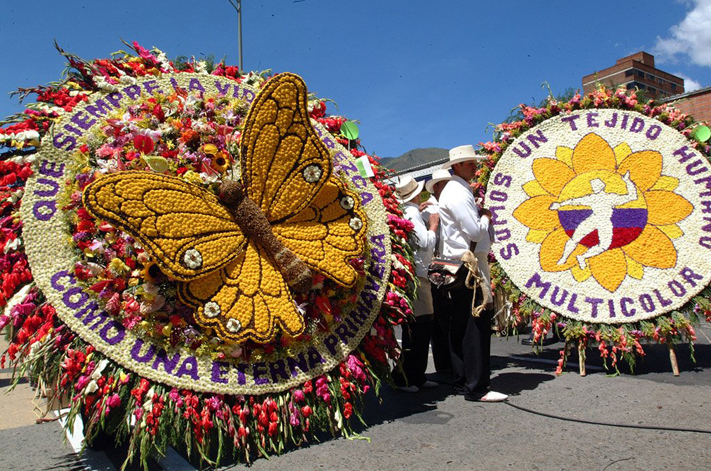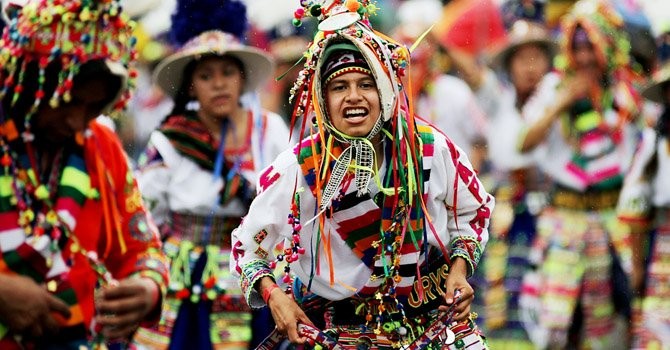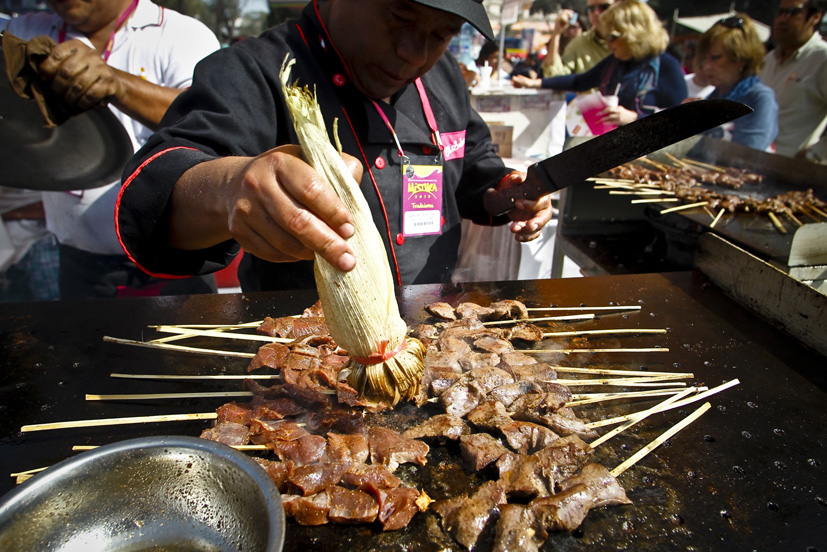1 – Flower Fair in Medellin, Colombia – 1-10 August every year
The city of Medellin is adorned with garlands of flowers and colours to mark the annual Flower Fair. This is the perfect opportunity to enjoy a few days viewing different kinds of parades, competitions, folkloric music concerts and of course the most renowned event of the fair, the silleteros parade. ‘Silleteros’ is the term used for the farmers who make beautiful flower arrangements on a silleta, a chair-like contraption for carrying flowers on a person’s back.
2 – Day of the Dead, Mexico – 1-2 November every year
Dia de los Muertos (Day of the Dead). The country’s most characteristic fiesta is the wonderfully macabre Dia de los Muertos. This event encompasses two days: All Saint’s Day, and All Souls day. The former honours all saints and people who died as children, and the latter is for souls who died in adulthood. If you are in Mexico around this time, expect to see sugar-candy skulls, skeletons and Pan de Muerto (Bread of the Dead) readily available at shops and supermarkets. Relatives of those who died gather at cemeteries throughout Mexico, bringing candles, pictures and music, along with bread, fruit, tequila, beer and favourite dishes of the people they are remembering. The mood is far from morbid: it is lively and upbeat!
3 – Oruro Carnival, Bolivia – 14-17 February 2015
This is the largest Carnival celebration in Bolivia. Dances, costumes and music are typically Andean. The Oruro Carnival is also known as the Diablada (Dance of the Devils) and is the number one tourist attraction in Bolivia. The Diablada is an extraordinary parade that showcases demonic dancers in extravagant costumes and it was shortlisted as a masterpiece by UNESCO. The entrance procession takes place on a Saturday before Ash Wednesday and features 20,000 dancers and 10,000 musicians. This massive celebration event draws approximately 400,000 people, the parade can last up to 20 hours.
4 – Semana Santa, Guatemala – Easter
This week-long event is a spectacular display of religious ritual and floral design, rivalled only by a similar event that takes place in Seville – Spain. Through billowing clouds of incense, accompanied by music processions of floats carried by purple-robed men make their way through the town. The cobbled stones are covered in carpets of flowers, known as ‘Alfombras de flores’. The floats ‘andas’ are crowned by colonial sculptures of the cross carrying Christ. This is the biggest Easter celebration in Latin America.
5 – Señor de los Milagros (Lord of the Miracles), Peru – 18, 19 & 28 October every year
Peru’s capital city – Lima, holds one of the largest Catholic processions in Latin America. It dates back to colonial times, when a black Angolan slave captured the image of a crucified Christ on a wall. Despite violent earthquakes hitting Lima in those days and attempts to erase it, the image remained intact. Thousands of devoted Catholics from various parts of Peru, gather at the Church of Las Nazarenas to follow the procession. 2,500 members of the Lord of the Miracles brotherhood carry the two-stone artwork through the various districts of Lima. Women wear purple dresses with a white robe which forms a belt and men wear purple ties.
6 – Inti Raymi – Festival of the Sun, Peru – 24 June every year
The sun was the principal object of Inca worship and at their winter solstice. The Incas honoured the solar deity with a great celebration known as Inti Raymi, the sun festival. To honour the Sun God, animals were sacrificed. A lucky actor is chosen to portray Sapa Inca (the emperor) and he’s carried in a golden chariot to the hilltop of Sacsayhuaman, which is a replica of the original which weighed about 60 kg. The procession starts in Qorikancha temple and passes through streets filled with music, dancing, prayers, flowers and ladies with brooms sweeping away evil spirits. Mama Ocllo, the wife and various priests and participants will join the procession. Once at the hilltop square, speeches are delivered in their language ‘Quechua’ and finally there is a simulation of a llama sacrifice so they can forecast the future for the Inca Empire.
7 – Mistura Festival (Gastronomy), Peru – September every year.
‘Mistura’ is the biggest food festival in Latin America. Mistura was launched in September 2008 and since then it has been growing fast, attracting visitors not only from Peru but from other countries in South America. At this festival, people from different backgrounds and cultures mingled to enjoy the amazing culinary tradition, dishes like the famous ceviche – marinated raw fish, cuy – deep fried guinea pig, sanguche de chicharron – steaming, salty crackling, their answer to the bacon butty. Other stands are devoted to Chifa and Nikkei (Chinese and Japanese respectively) fusion cuisines which makes Peruvian food so unique and appetizing. A country where class barriers fall when it comes to food, everyone samples and enjoys the same dishes at Mistura.






